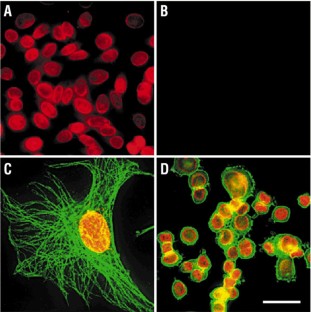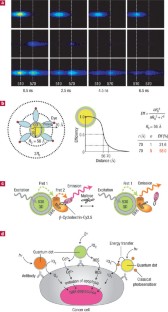39 semiconductor nanocrystals as fluorescent biological labels
Histology, Staining - StatPearls - NCBI Bookshelf Medical Histology is the microscopic study of tissues and organs through sectioning, staining, and examining those sections under a microscope. Often called microscopic anatomy and histochemistry, histology allows for the visualization of tissue structure and characteristic changes the tissue may have undergone. Because of this, it is utilized in medical diagnosis, scientific study, autopsy ... Time for NanoNeuro | Nature Methods Bruchez, M. Jr. Semiconductor nanocrystals as fluorescent biological labels. Science 281 , 2013-2016 (1998). CAS PubMed Article Google Scholar
Are quantum dots ready for in vivo imaging in human subjects? Colloidal fluorescent semiconductor nanocrystals known as quantum dots are roughly spherical, have distinctive optical, electronic, and photophysical properties, and have exciting potential uses in biological labeling, imaging, and detection as well as as effective fluorescence resonance energy transfer donors.

Semiconductor nanocrystals as fluorescent biological labels
en.wikipedia.org › wiki › Quantum_dotQuantum dot - Wikipedia They have potential uses in diode lasers, amplifiers, and biological sensors. Quantum dots may be excited within a locally enhanced electromagnetic field produced by gold nanoparticles, which then can be observed from the surface plasmon resonance in the photoluminescent excitation spectrum of (CdSe)ZnS nanocrystals. High-quality quantum dots ... The surface science of nanocrystals | Nature Materials 22/01/2016 · The role of surface ligands in tuning the optoelectronic properties, controlling the stability and determining the performance in applications of colloidal nanocrystals is discussed in this Review. › articles › s41377/022/00913-6Liquid crystal-templated chiral nanomaterials: from chiral ... Jul 14, 2022 · The strong interaction of chiral nanomaterials with electromagnetic waves in the spectral regions, ranging from microwave and terahertz to infrared, visible and ultraviolet regions, is the ...
Semiconductor nanocrystals as fluorescent biological labels. How do you prepare quantum dots? - Peculiarities Bite What are quantum dots? Colloidal fluorescent semiconductor nanocrystals known as quantum dots are roughly spherical, have distinctive optical, electronic, and photophysical properties, and have exciting potential uses in biological labeling, imaging, and detection as well as as effective fluorescence resonance energy transfer donors. Interface polarization in heterovalent core-shell nanocrystals Colloidal semiconductor NCs exhibit size-dependent tunable bandgap and narrow emission bandwidth 1,2,3,4,5, which put the materials on the map in optoelectronic 6,7,8,9,10,11,12 and biological ... PharmaCircle This website uses cookies to help provide you with the best possible online experience. Please read our Terms & Conditions and Privacy Policy for information about ... › topics › agricultural-andQuantum Dot - an overview | ScienceDirect Topics QDs are colloidal fluorescent semiconductor nanocrystals (2–10 nm) with narrow emission and a broad range of absorption bands. This material is predominantly used in fabricating imaging probes [68]. The central core of QDs consists of combinations of elements from groups II–VI of the periodic system (CdSe, CdTe, CdS, PbSe, ZnS, and ZnSe) or ...
What are quantum dots? - Nanowerk Quantum dots (QDs) are man-made nanoscale crystals that that can transport electrons. When UV light hits these semiconducting nanoparticles, they can emit light of various colors. These artificial semiconductor nanoparticles that have found applications in composites, solar cells and fluorescent biological labels. Single-Molecule Super-Resolution Imaging | Nikon’s MicroscopyU Stochastic Optical Reconstruction Microscopy, STORM, is one of a family of Nobel Prize winning super-resolution Single Molecule Localization Microscopies (SMLM) for the visualization of biological systems with an optical resolution measured in the tens of nanometers (nm) in the x, y, and z directions.Pioneered in the laboratory of Xiaowei Zhuang at Harvard University, this … Biological Science 1 And 2 - Cygnis Media Nanocrystals as Fluorescent Biological Labels - ScienceDepartment Of Biological Sciences Hunter College - ... Size- and material-dependent emission spectra of several surfactant-coated semiconductor nanocrystals in a variety of sizes.The blue series represents different sizes of CdSe nanocrystals with diameters of 2.1, 2.4, 3.1, 3.6, and 4.6 nm ... Semiconductor Nanocrystals for Biological Imaging Page: 13 of 24 Conventional organic fluorophores suffer from poor photo stability, narrow absorption spectra and broad emission feature. Semiconductor nanocrystals, on the other hand, are highly photo-stable with broad absorption spectra and narrow size-tunable emission spectra. Recent advances in the synthesis of these materials have resulted in bright, sensitive, extremely photo-stable and biocompatible ...
EOF Semiconductor Nanocrystals for Biological Imaging Page: 10 of 24 Conventional organic fluorophores suffer from poor photo stability, narrow absorption spectra and broad emission feature. Semiconductor nanocrystals, on the other hand, are highly photo-stable with broad absorption spectra and narrow size-tunable emission spectra. Recent advances in the synthesis of these materials have resulted in bright, sensitive, extremely photo-stable and biocompatible ... Quantum Confinement Effect - an overview | ScienceDirect Topics In Nanostructured Semiconductor Oxides for the Next Generation of Electronics and Functional Devices, 2014. 6.5.2 PbS and PbSe quantum dot layers. It has been reported that the quantum confinement effect contributes to the extension of the photovoltaic potential of low-bandgap semiconductors such as PbS or PbSe (bandgaps are about 0.41 157 and 0.27 eV 158 for PbS … Liquid crystal-templated chiral nanomaterials: from chiral ... - Nature 14/07/2022 · The strong interaction of chiral nanomaterials with electromagnetic waves in the spectral regions, ranging from microwave and terahertz to infrared, visible and ultraviolet regions, is the ...
Cd+2-sensing property of highly luminescent CdTe nanocrystals in the ... In this research, CdTe nanocrystals (NCs) of different sizes were synthesized through a chemical precipitation technique and used as the fluorescence probe of Cd ions in the fluorescence turn-on mode. Then, they were combined with various concentrations of Cd2+ ions as well as Na2S2O3 as a source of S. Na2S2O3 was applied to increase the sensing ability of the sensors in the range of 1 to 1000 ...

Immunofluorescent labeling of cancer marker Her2 and other cellular targets with semiconductor ...
Core/Shell NaGdF4:Nd3+/NaGdF4 Nanocrystals with Efficient Near-Infrared ... The PL spectrum of colloidal NaGdF 4 nanocrystals doped with 3% Nd 3+ (hexane suspension) under laser excitation at 740 nm is shown in Figure 2A.Three PL bands are clearly resolved; they have maxima at ~860-900, ~1050, and ~1330 nm, corresponding to the transitions from the 4 F 3/2 state to the 4 I J (J=9/2, 11/2, 13/2) state of Nd 3+ ions, respectively. The generation mechanism is based on ...
› topics › engineeringQuantum Confinement Effect - an overview | ScienceDirect Topics In Nanostructured Semiconductor Oxides for the Next Generation of Electronics and Functional Devices, 2014. 6.5.2 PbS and PbSe quantum dot layers. It has been reported that the quantum confinement effect contributes to the extension of the photovoltaic potential of low-bandgap semiconductors such as PbS or PbSe (bandgaps are about 0.41 157 and 0.27 eV 158 for PbS and PbSe, respectively) by ...
PDF - Biological applications of colloidal nanocrystals PDF - Due to their interesting properties, research on colloidal nanocrystals has moved in the last few years from fundamental research to first applications in materials science and life sciences. In this review some recent biological applications of colloidal nanocrystals are discussed, without going into biological or chemical details. First, the properties of colloidal nanocrystals and how ...
Semiconductor Quantum Dots and Core Shell Systems for ... - SpringerLink Semiconductor Quantum Dots and Core Shell Systems for High Contrast Cellular/Bio Imaging Download book PDF. ... A.P. Alivisatos, Semiconductor nanocrystals as fluorescent biological labels. Science 281, 2013-2016 (1998) Google Scholar G.D. Luker, K.E. Luker, Optical imaging: current applications and future directions. J. Nucl.
The Electronic Structure of Semiconductor Nanocrystals1 Abstract We review the rapid progress made in our understanding of the crystal properties of semiconductors and nanocrystals focussing on theoretical results obtained within the multiband effective mass approximation. A comparison with experiment shows these results are valid for nanocrystals down 22-26 A in diameter. The effect of the electron-hole Coulomb interaction on the optical spectra ...
EP2287614B1 - Semiconductor nanocrystal probes for biological ... EP2287614B1 EP10010743.2A EP10010743A EP2287614B1 EP 2287614 B1 EP2287614 B1 EP 2287614B1 EP 10010743 A EP10010743 A EP 10010743A EP 2287614 B1 EP2287614 B1 EP 2287614B1 Authority
Droplet-based microfluidics - Wikipedia Droplet-based microfluidics manipulate discrete volumes of fluids in immiscible phases with low Reynolds number and laminar flow regimes. Interest in droplet-based microfluidics systems has been growing substantially in past decades. Microdroplets offer the feasibility of handling miniature volumes (μl to fl) of fluids conveniently, provide better mixing, encapsulation, sorting, …






Post a Comment for "39 semiconductor nanocrystals as fluorescent biological labels"